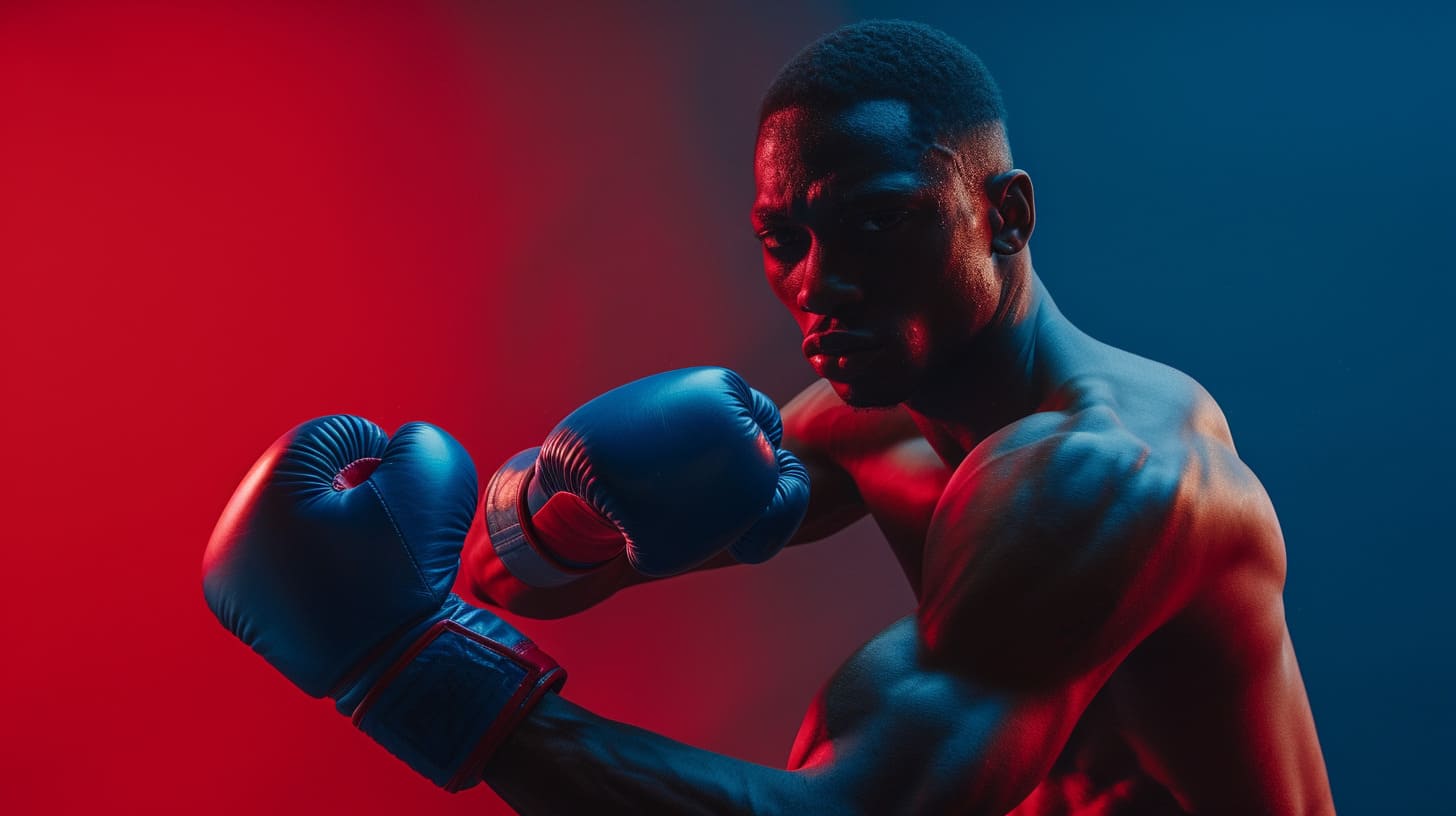Free flow boxing style represents the art of fluid movement and adaptability in the ring, allowing boxers to switch tactics on-the-fly and keep their opponents guessing. It’s a dynamic and improvisational approach to fighting, emphasizing creativity and finesse over rigid techniques. Picture the way a great jazz musician might riff off a standard tune, the free flow boxer dances around the ring, weaving a tapestry of punches that feels both spontaneous and harmonized. Now, let’s dive into the rhythmic world of free flow boxing and explore the key principles that allow fighters to master this lyrical, elusive art form.
What Is Free Flow Boxing Style?
Ever heard of free flow boxing and wondered what it’s all about? It’s like the jazz of the boxing world, where creativity meets agility in the ring. Let’s dive into the core elements that make up this unique boxing style.
Core Principles and Techniques
In the heart of free flow boxing style, there’s an emphasis on individuality and fluidity. It’s less about prescribed combinations and more about the adaptability of the boxer to the dynamic circumstances of the match. Here are the core principles and techniques that define this approach:
- Adaptability: This style prizes the ability to change up techniques on-the-fly, responding intuitively to the opponent’s movements.
- Fluidity of Movement: Free flow boxers prioritize smooth, continuous motion, which makes their attacks and defenses less predictable.
- Rhythm Break: By varying the tempo of their moves, they can disrupt the opponent’s rhythm, creating openings for attack.
Stance, Footwork, and Guard
The stance in free flow boxing is generally more relaxed and versatile. In comparison to conventional boxing, where the stance is firmer and more stable, free flow boxing allows for a wider range of movement. Here’s a rundown on the stance, footwork, and guard:
- Stance: Fluid and mobile, allowing for rapid directional changes.
- Footwork: Quick and light, enabling the boxer to maneuver around the ring with ease.
- Guard: Less rigid, often changing positions, which can confuse opponents and provide defensive agility.
Distinction from Conventional Boxing Techniques
Conventional boxing teaches boxers a more structured approach, with heavy focus on established combinations and movements. Free flow boxing, however, thrives on the concept of improvisation. Here’s how it stands apart:
- Unpredictability: Free flow boxing is harder to read and anticipate than traditional boxing styles.
- Creativity: While conventional boxers execute well-practiced combos, free flow boxers create their moves in real-time.
- Variability: Instead of repeating the same patterns, free flow boxers constantly vary their attacks.
Using these concepts, free flow boxers craft a dance-like style that can be mesmerizing and highly effective in the ring. It’s about matching technique with the boxer’s own natural rhythm, creating a style that’s as unique as a fingerprint.
Signature Moves & Strategies in Free Flow Boxing Style

When you think of free flow boxing style, it conjures up images of fluid movement, rhythmic footwork, and a chess-like anticipation of the opponent’s next move. This improvisational and reactive approach to boxing centers on three core moves and strategies that can turn a skilled boxer into a ring maestro.
1. Fluid Footwork and Angling
One of the most captivating aspects of free-flow boxing is the ability to glide around the ring, making an opponent miss and pay. This isn’t just about having quick feet; it’s about strategic positioning.
- Key Benefits:
- Avoids punches effortlessly
- Sets up own strikes from unique angles
- Keeps the opponent uncertain and off-balance
Example in Action: Take someone like Vasyl Lomachenko, known for his ‘Matrix-like’ movement. His footwork isn’t just defensive; it’s offensive, letting him create angles that opponents don’t see coming.
2. Adaptive Guard and Defense
A dynamic guard that adjusts to incoming threats is fundamental in free flow boxing. Rather than a static defense, fighters fluidly transition between high guards, half guards, and shoulder rolls in response to their opponent’s strikes.
- Key Benefits:
- Maximizes protection from various attacks
- Confuses opponents with unpredictability
- Opens avenues for counter-attacks
Example in Action: Floyd Mayweather’s patented shoulder roll, or Philly Shell, epitomizes an adaptive defense. It’s not just about evading punches; it’s about deflecting and returning fire instantly.
3. Rhythmic Feinting and Misdirection
A master of the free flow boxing style often uses rhythm as a weapon, throwing off an opponent’s timing with clever feints and misdirection plays.
- Key Benefits:
- Disrupts opponent’s defensive rhythm
- Creates openings for strikes
- Frustrates and tires the opponent mentally
Example in Action: Muhammad Ali’s ‘dancing’ could mesmerize and then, in the blink of an eye, he delivered his ‘sting like a bee’ punches—often when opponents least expected them.
Each of these moves and strategies not only contributes to the spectacle of a boxing match but also represents layers of tactical depth. They are the strokes on a canvas that a fighter uses to paint their masterpiece in the ring, and they’ve been employed by some of the sport’s most legendary names to create unforgettable moments and victories.
Challenges and Limitations

When you float like a butterfly in the ring, it’s no secret that there could be some turbulence ahead. Let’s dive into some potential curveballs you might face when adopting the free flow boxing style.
The Benefits of the Free Flow Boxing Style
Let’s talk perks! The free flow boxing style is a bit like jazz – it’s all about improvisation and rhythm. It’s smooth, it’s unexpected, and it can lead to some serious in-ring success when used right. Here are some situations where you can really make this style shine:
- Matchups Against Predictable Fighters: If your opponent is as easy to read as a bedtime story, the free flow style keeps them guessing.
- Long Fights: Got stamina? Use the free flow to conserve energy and outlast your opponent.
- When Flexibility is Key: If you need to adapt quickly to your opponent’s tactics, free flow boxing lets you switch it up on the fly.
- Taking Control of the Pace: Set the rhythm of the fight and make your opponent dance to your tune.
- Maximizing Reach: Use your limbs’ full extension to keep your opponent at bay while you weave and bob.
The Drawbacks of the Free Flow Boxing Style
Even the most thrilling roller coasters have their downsides. Here’s where free flow might get you tangled in the ropes:
- Against Aggressive Power Punchers: If you’re up against a heavy hitter, sometimes free flow can leave you too open to a lights-out blow.
- Inexperience With the Style: It’s an art form, and without the Picasso-level skill, you could end up with more of a boxing blooper reel.
- Underestimating Opponent’s Adaptability: If they’re good at mirroring your moves, your fluidity might not give you the edge.
- Overusing Movement: You could end up dancing yourself into a corner—or worse, gasping for air when you need to be going the distance.
- Judges’ Scoring Preferences: If the judges prefer traditional tactics, you might not rack up the points you’re hoping for.
There’s no one-size-fits-all in boxing—every style has its moment to shine and its Achilles’ heel. The key is to know when to flow and when to switch it up. Keep these pointers in mind, and you’ll be ready to groove your way to victory, or at least have a darn good time trying!
Defending against Free Flow Boxing Style

So you’ve come up against a boxer with a free-flow style, huh? It’s like trying to nail jelly to the wall, right? These slick movers are unpredictable, rhythmic, and can make you feel like you’re always a step behind. But fear not! I’ve got some primo tips to help you anticipate their moves and stay in control.
Understanding the Free Flow Fighter
Before you can defend against a free-flow boxer, it’s key to wrap your head around what you’re dealing with. Free flow fighters are like jazz musicians — they’re all about improvisation. They won’t stick to a rigid pattern, which can make them a tricky opponent to read. But like any good tune, you can learn to feel the rhythm.
Read the Rhythm
- Stay Light on Your Feet: Keep bouncing and stay mobile. It’s harder to hit a moving target, right? Plus, it helps you adjust your position quickly in response to your opponent’s freestyling.
- Keep Your Guard Adaptive: Rather than a tight, static guard, keep it loose and ready to respond wherever the punches are coming from.
Stay Unpredictable
- Mix Up Your Defense: If you’re as unpredictable as they are, it’s like fighting fire with fire. Throw in some feints, change levels, and use lateral movements to keep them guessing.
Additional Practical Tips:
Sharpen Your Reflexes
Practice drills that boost your reaction time. The faster you can read and respond to the free-flow boxer’s moves, the better you’ll be able to defend against their spontaneous burst of attacks. Sparring with different partners can expose you to a variety of styles, which is gold for reflex training.
Control the Pace
Dictate the tempo of the bout. Use your jab to keep the rhythm in your favor, and don’t be afraid to clinch when you need to slow down their tempo. It’s like taking the drummer out of the band—disrupt their rhythm, and you disrupt their flow.
Optimize Your Footwork
Great footwork can get you out of tight spots and into advantageous positions. Work on drills that enhance your agility and balance. This will help you to quickly pivot away from attacks and employ countermeasures effectively.
Remember, champs, boxing’s not just about throwing punches—it’s a dance. And when you’re facing a free-flow stylist, the key is to be just as smooth on your feet. With these pointers, you’ll be sliding through their rhythm and making the right moves in no time! Keep these tips in your corner, and you’ll have the upper hand in the dance of fists. Happy sparring!
Notable Practitioners
When it comes to the slick, rhythmical dance of free flow boxing, some fighters have etched their names in history with their mastery of this artful approach. Let’s turn the spotlight on three legendary practitioners who have become synonymous with this style.
Muhammad Ali
The man who proclaimed himself “The Greatest” wasn’t just boasting — Muhammad Ali’s unique combination of speed, grace, and tactical genius set a new standard for free flow boxing. His career is studded with accomplishments, including winning the world heavyweight championship three times — a feat that was unprecedented at the time.
- *Olympic Gold Medalist (1960 Rome, Light Heavyweight)
- *Three-Time World Heavyweight Champion (1964, 1974, 1978)
- *First Boxer to Win the Heavyweight Title Three Times
Ali’s influence extended beyond his championship belts. He became famous for his footwork, dubbed the “Ali Shuffle,” and his ability to “float like a butterfly, sting like a bee.” One of his most memorable fights showcasing his free flow style was the “Rumble in the Jungle” against George Foreman in 1974, where his rope-a-dope strategy and fluid movement secured him a historic victory.
Roy Jones Jr.
Often regarded as one of the most talented boxers to ever lace up gloves, Roy Jones Jr. brought an unprecedented level of athleticism to the ring. His accomplishments are numerous, but his reign throughout the 1990s as a near-untouchable champion across multiple weight divisions is particularly notable.
- *Numerous World Titles in Four Weight Classes (Middleweight to Heavyweight)
- *Named “Fighter of the Decade” for the 1990s (by the Boxing Writers Association of America)
- *One of the Best Pound-for-Pound Boxers in History
Jones Jr. was recognized for his incredible hand speed, reflexes, and unorthodox style, baffling opponents with movements that seemed to defy convention. The fight that encapsulated his free flow mastery was perhaps his battle against James Toney in 1994 for the IBF super middleweight title, where he danced around one of the era’s toughest fighters with apparent ease.
Vasyl Lomachenko
Bringing the free flow style into the contemporary arena, Vasyl Lomachenko has been dazzling boxing fans with a combination of fluid movement, impeccable footwork, and an acute tactical mind. Hailing from Ukraine, Lomachenko quickly transitioned from an outstanding amateur career to become one of the fastest boxers to win a world title in just his third professional fight.
- *Two-Time Olympic Gold Medalist (2008 Beijing, 2012 London)
- *Titles Across Three Weight Divisions in Record Time
- *Renowned for his High Boxing IQ and Footwork
One of the most illustrative fights of Lomachenko’s mastery of free flow boxing was his bout against Guillermo Rigondeaux in 2017, where he outclassed an opponent who was himself a two-time Olympic gold medalist. Lomachenko’s “Matrix” style rendered him almost untouchable and showcased the epitome of modern free flow boxing.
Each of these boxers transformed the boxing ring into their own canvas, and with the brushstrokes of their gloves, painted masterpieces that continue to inspire and inform the sweet science’s evolving landscape.
Training and Conditioning for Free Flow Boxing Style
Getting into the groove of the free flow boxing style means optimizing your training to fit its dynamic nature. This style emphasizes fluidity, rhythm, and adaptability, allowing you to glide around your opponent like water – so your training should reflect that fluidity.
Drills to Embrace Free Flow
Let’s get down to the nitty-gritty. To nail that free flow style, your drills should focus on movement, speed, and reflexes. These exercises are your bread and butter:
- Shadowboxing with a Twist: Instead of the usual rigid motions, try incorporating unconventional movements. Change levels, mix in combat dance elements, and focus on transitioning smoothly from one stance to another.
- Speed Bag Work: This classic is perfect for developing rhythm. Vary your pace, throw in some feints, and never let the pattern become predictable. Keep that bag dancing to YOUR tune.
- Sparring Sessions: Light, technical sparring is where you truly bring the free flow to life. Keep it playful, aim to move more and get hit less. Use the entire ring and all the angles to your advantage.
- Reaction Drills: Work with a partner throwing random combinations at you while you practice slipping, ducking, and flowing with the punches.
Incorporating these drills into your regular boxing routine will start to ingrain the patterns and movement philosophies that define free flow boxing style into your muscle memory.
Conditioning the Free Flow Fighter
Now, let’s beef up with some conditioning work:
- Dance Classes: Yes, you read that right! Engage in dance classes to improve your rhythm, footwork, and body coordination.
- Agility Ladder Drills: Mastering agility is key. Hone your ability to move quickly and change direction on a dime.
- Plyometric Exercises: Incorporate jump squats, box jumps, and burpees to boost explosive power and improve overall athleticism.
- Yoga: To free flow, you need flexibility and core strength, both of which yoga can provide.
Top Tips for Free Flow Mastery
Before you lace up those gloves, here are a few tips to keep in mind as you pursue the free flow boxing style:
- Stay Loose: Tension is the enemy of flow. Work on staying relaxed, especially in your shoulders and hips.
- Find Your Rhythm: Listen to music while you train and move to the beat. It could help you internalize timing and flow.
- Be Creative: Free flow boxing is as creative as it is athletic. Don’t be afraid to experiment with new movements.
- Mindset Matters: Adopt a playful approach to sparring and training. Learn to enjoy the dance of boxing.
By focusing on these tips and incorporating the suggested drills and exercises into your routine, you’re well on your way to mastering the fluid art of free flow boxing. Remember, it’s about harmonizing with the rhythm of the fight and letting your instincts take the lead. Keep at it, and soon you’ll be boxing to a rhythm all your own.
Final Thoughts
So, you’ve danced through the ins and outs of free flow boxing, twirled around its core principles, and shadowboxed with its strategies — by now, you should be feeling that rhythm in your gloves! Free flow boxing isn’t just a style; it’s a state of being that lets you sync your body and mind to create an unpredictable, poetic form of combat. Like a jazz session in full swing, it’s spontaneous, it’s inventive, and when done right, it’s downright beautiful.
Whether you’re bobbing and weaving through your own free flow journey or learning how to counter the style, remember to stay fluid, embrace your unique rhythm, and keep refining your moves. Who knows? With enough practice, you might just become one of those legendary boxers who turn the ring into a dance floor. Now, go forth and let your own free flow story unfold — made up of jabs, hooks, and perhaps a mean uppercut. Keep on swinging, and as always, keep on grooving in the grand dance of boxing!
Additional Resources
Diving into the free flow boxing style can be incredibly exciting and enriching. If you’re keen to deepen your understanding and refine your skills, there’s a wealth of information out there. I’ve put together a handy list of resources that can take your knowledge to the next level – think of it as your personal library for all things free flow boxing!
Books to Power-Up Your Knowledge
- “The Fighter’s Mind” by Sam Sheridan — This gem offers insights into the psychological aspects of fighting, crucial for a style that emphasizes adaptability and fluidity. Get it on Amazon
- “Boxing’s Ten Commandments” by Alan Lachica — Although not solely about free flow boxing, this book provides fundamental principles that are beneficial across all boxing styles. Grab a Copy Here
Online Articles for the Keen Reader
- “The Philosophy of Flow in Martial Arts” — Explore how the concept of flow is integral to martial arts, including boxing. Read the Full Article
Videos to Visualize the Flow
- “Mastering the Art of Flow in Boxing” — A YouTube tutorial offering drills and exercises to help you embody free flow movements. Watch the Tutorial
- “Boxing Footwork Drills for Fluid Movement” — Excellent for building the kind of footwork that’s vital for a free-flowing boxing style. View the Drills Here
Documentaries That Inspire
- “Champs” — Although not exclusively about free flow boxing, “Champs” offers a look into the lives of champions and their diverse styles, inspiring any boxer in their journey. Stream on Netflix
Each of these resources can provide you with a different perspective or skill set to add to your training regimen. From understanding the mental game to perfecting your footwork, you’ll be well on your way to developing a boxing style that’s as fluid as water.

